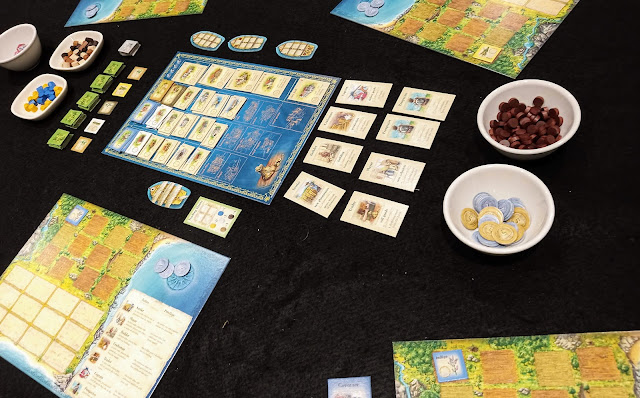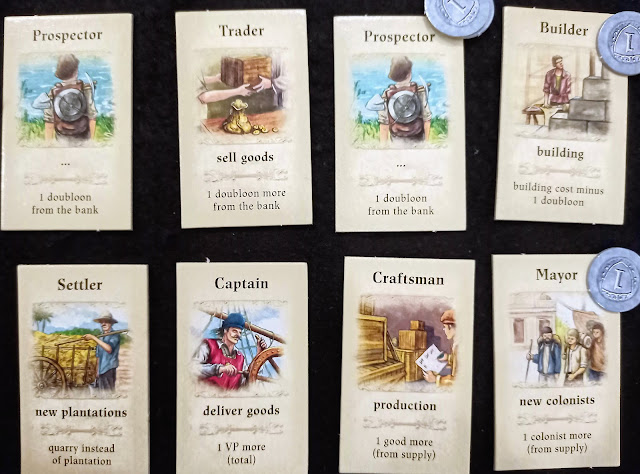This change of scale brings in many differences. Most obvious is that there are fewer rules and fewer options for you the player to choose from. Instead of drawing a hand of cards each turn containing a variety of actions and having to juggle where you consider the main threats currently to be coming from across three locations, you can take five actions from among four choices: fire to eliminate an enemy counter, fire to place suppression markers, move from one area to another or turn a unit counter back to fresh from exhausted.
The result is a much quicker game to learn and a much quicker game to play. It took several plays of Pavlov's House and constant referral to the Play Aid to get to know what the choices written on each card offered you. Here you will have memorised your actions and the enemies after a single play. But, DO NOT think that this makes the current game inferior. Both are intense struggles. Both demand that you prevent an enemy unit from reaching and breaching its objective building, though there are other ways to lose in Pavlov's House!
Though the terrain is obviously abstracted to a certain degree, there is far more sense of place here, as a glance at the board reveals. Initially at set up, there are only German attackers, one rifleman in each of the twelve starting locations, and the five French prisoners lodged in the cellar, which in real life would be below the castle, but here is placed in the bottom left corner.
In the picture above, the rest of the game's physical components can be seen. Above the board are the various markers: Action Tokens, Command Tokens, Disrupted Tokens, 1 Load Token [for loading the tank's main gun!] and Suppression Tokens. Below it on the left are the range of SS counters [lots more riflemen, scouts, sturm troopers, machine gunners and mortars]. In the centre are three reinforcements for the defenders, to their right the German wermacht defenders and then on the far right the American defenders.
A closer look at the main part of the castle
Every single item is substantial from the glossy mounted board to the large, thick individual counters. As with Pavlov's House, many of the defenders are named and, in a touch that contributes to the atmosphere of the situation, have special attributes identified by a capital letter. Some of the rank and file German defenders have low morale which is offset by the presence of an officer in the same location. Four of the five French prisoner defenders can inspire others in the same location by adding a die to their attack value. Those Americans marked with a T for tank can make use of several special locations [mainly on the tank itself] that significantly boost attack and suppression dice, while the senior Wermacht officer has the sacrifice ability to die in the place of one French defender who becomes a casualty.
Most of the Defenders
Once again these unit counters are of a very satisfying size and robustness which makes both for ease of handling and ease of reading the information on them.
The rule book is a model of clarity and personally I'm pleased with the decision to move to an A4 format which makes for ease of handling. It's a glossy well laid out product with numerous full colour examples to support every detail of the game from set up, explanation of counters and cards and every action that can be performed.
It is a very straightforward game to get into. A turn involves the five actions taken by you, followed by drawing three cards from the German deck and carrying out the instructions on them. The first four turns are swift and particularly easy for you the defender as each turn you must use each of your five actions to place one of your defenders on the board and perform an action with them. At this early stage of the game, this will mainly be placing suppression markers.
The curiously named tank, Besotten Jenny, fully crewed
From then on the fun and thrill of the game is deciding on what five actions to take and then awaiting the resolution of each of the three German cards which must be drawn and executed one by one. Your two aggressive actions are firing at a single enemy unit or placing suppression markers that can be used to fire at an enemy unit only when it is first placed on the board.
Once one of your units has taken an action, it is flipped to its exhausted side and it then takes an action simply to turn it back to its active side again. Moving a unit within a location is a free action thus allowing the chosen unit to do something else, but moving from one location to another is a complete action. Soon some of your men are going to become disrupted and, yes, it takes an action just to remove a Disrupted marker.
You have a few units that have the special Command ability to perform three actions on other units that occupy the same location. Mainly these will be used to remove a Disruption marker or refresh an exhausted unit. But such affected units are marked with Command markers to show that you can't then use them in the same turn.
Always there are more actions needing to be taken than the five you are allotted and as the various SS units begin to encroach nearer and nearer on their allotted paths to the castle, the tension is ratcheted up.
Here are some of your worst enemies. The machine gunners and mortar teams cannot advance to take the castle, but remain on starting points for the opportunity to lay down fire when the appropriate cards are drawn, while the Sturm units are the most difficult to kill of your opponents that will be advancing down the avenues of attack!
All the SS actions are governed by the turn of three cards each turn. These cards are a range that mingle the introduction of units that can advance and those that are stationary, but can fire along with a variety of actions directed to suppress units, damage the fabric of the castle or seek to destroy your one and only tank.
All these involve dice rolls that often seem to have a mind and will of their own! As these rolls are based on two D6, with the expected range of 2-12, laying down suppressive fire on areas 6-8 is advisable particularly early in the game. But typically always expect the unexpected. Having built up just such a defensive shield against those areas, I was subjected to a series of low rolls of 4s and 5s that had the enemy units streaming in on the opposite side of the board.
I've had the tank survive all rolls against it and at other times seen it brew up along with a full complement of soldiers destroyed with it. My leading German officer has been sniped at and killed as my first casualty, while a terrace full of soldiers has come through unscathed.
Here is one of my more ignominious defeats, as the SS breach the castle. Technically you lose immediately 1 unit makes it into the castle, but I couldn't resist seeing how bad the effects of the killing card play was and, as you can see, three units have breached my defences, with two more lined up behind them.
All in all, I've found Castle Itter a fast playing, nail-biting experience, very easy to learn and highly rewarding to play. What's more, should you find it easier to survive than I do, there is an excellent Tactical deck of cards that can be introduced that turns the screw from merely difficult to insanely impossible! Don't say you haven't been warned.
I've no hesitation in recommending this as an addition to anyone's collection and count
Pavlov's House with
Castle Itter as a perfect pairing.















Follow Us